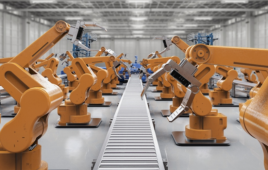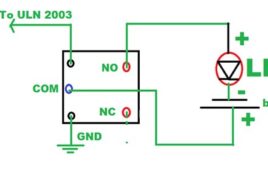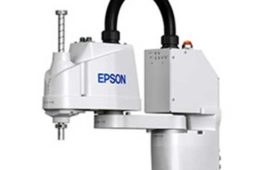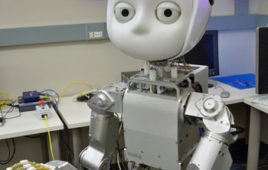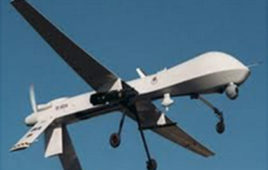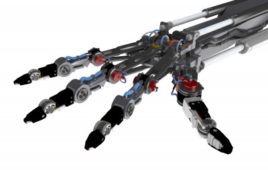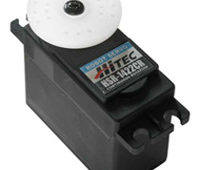When you think of robots, you might imagine those in science fiction movies such as Terminator, Star Trek, Star Wars, etc. However, industrial robots take many shapes and forms, including rovers, drones, surgical arms, humanoids, and even vehicles. There are several types of robots used in industries such as manufacturing, aerospace, automotive, search and rescue,…
What materials are used to build robots?
The advent of robots has carried forward a legacy that originated with the Industrial Revolution. Since the introduction of the first industrial robot in the 1950s, robotics has undergone several decades of evolution. These conventional machines have since permeated nearly every industry, with the innovation of soft robots now changing the game. Soft robots are…
What are the components of robotic arms and industrial robots?
Industrial robots are designed for use in industrial automation. They’re programmable machines that are specifically used to automate production-related tasks. Typically, several robots are installed in an assembly line, each responsible for a specific objective. For example, some pick and place workpieces, some interact with different equipment (such as a lathe or milling machine), and…
How drones are serving next-generation logistics
E-commerce is no longer novel. Online shopping delivered to one’s doorstep has become a typical millennial lifestyle. The backbone of the e-commerce industry is the shipping and logistics sector. However, of the biggest challenges for shipping companies is the timely delivery of orders at the lowest possible cost. Digitalization has helped by providing real-time tracking…
Introduction to Robotics
I’m just conveying my emotions about robots to you. So people what is robotics?? You might be getting confused about the question itself.. Funny.. But in actual Robotics it is a wide field. Robotics is term denoted with respect to robots. WHAT is a ROBOT??Roughly we can say, ROBOT is a machine with brain and memory. Some bookish language may be elaborating it like “A reprogrammable, multifunctional manipulator designed to move material, parts, tools, or specialized devices through various programmed motions for the performance of a variety of tasks”. This definition is pretty expressive.
Epson to Release new T Series Robots to expand its SCARA Lineup
Epson Corporation, a global technology leader, has announced to expand the lineup of industrial SCARA (Selective Compliance Assembly Robot Arm) robots by adding a new T series of robots. The first model in the series to be released is T3, which will be made available in limited markets in late March followed by its rollout in other regions. The T3 model has been designed primarily for simple material handling applications like test machine loading/unloading. It would offer the companies and opportunity to employ robots for non-creative and repetitive work which has been usually performed by operators like transporting components.
Swarm Robotics
“When everybody thinks alike, nobody is thinking much”, is so rightly said. Think out-of-the-box and you potent some innovation or maybe an invention; credits to your gamut. To speak in line with the concept here, swarming population; not always, is a bad idea. How about rescuing some disaster hit zone with swarming intelligent population or maintaining a warehouse with moving, self-operational shelves?? A great idea indeed. Everybody must have noticed the movement of ants or similar insects. It is awesomely coordinated and aligned with respect to each other. They accomplish their task collectively by keeping an eye on each other’s movement. This type of coordinated movement in insects is termed as Swarm and when this movement is performed by some group of robots then in technical terms it is called as “Swarm Robotics” inspired by colonies of ants and swarms of bees.
Humanoid Robots : An Overview
A Humanoid may be defined as something that resembles or looks like a human and having characteristics like opposable thumb, ability to walk in upright position, etc. Nowadays the concept of humanoids is being widely implemented in robotics and these robots are called Humanoid Robots or may be simply “Humanoids”. In general humanoid robots have a torso with a head, two arms and two legs, although some forms of humanoid robots may model only part of the body, for example, from the waist up. Some humanoid robots may also have a ‘face’, with ‘eyes’ and ‘mouth’. Androids are humanoid robots built to resemble a male human, and Gynoids are humanoid robots built to resemble a human female.
Military Robotics: Robots in the Military
The utilization of robotics in military is well shown by US army. Osama and other terrorists were tracked by these military robots. They are robust, they are obedient, they are daring, they don’t have fear of death, and most important they have proved themselves in Iraq and Afghanistan. Now, terrorists are terrified by drone attacks. The utilization of robotics technology in military led to a new field in robotics i.e. Military Robotics.Military robotics isn’t about creating an army of humanoids but utilization of robotics technology for fighting terror and defense of the nation. Thus, military robots needn’t to be humanoids or they not necessarily need to carry weapons, they are just those robots that can help the armed forces.
Introduction to Robotics
Other than the sci-fi movies, the robots can be seen around us assembling the cars, in bottling factory etc. The robots have been in the industry for last two decades because of their continuous working ability in an atmosphere, where humans are not even able to stand for minutes, without any supporting equipment, like space.Basic structure of robots is very much similar to humans. How do humans sense? For example a human sees something and sends neural signals to the brain via neurons and reacts accordingly. The development of all these senses in Robots artificially is achieved through Sensors.
Mechatronics : An Overview
Mechatronics refers to the successful combination of mechanical systems and electronics. In mechatronics, traditional systems of mechanical engineering are [[wysiwyg_imageupload::]]fused together with components from computer science, mathematics and electrical engineering. Mechatronics provides solutions that are efficient and reliable systems. Mechatronic systems mostly have microcomputers to ensure smooth functioning and higher dependability. Few examples of mechatronics system are automated guided vehicles, robots, digitally controlled combust engines and machine tools with self-adaptive tools, aircraft flight control and navigation systems, and smart home appliances.
Servo Motor : Basics and Working
Servo refers to an error sensing feedback control which is used to correct the performance of a system. Servo or RC Servo motors are DC motors equipped with a servo mechanism for precise control of angular position. They are used in robotic arms and legs, sensor scanners and in RC toys like RC helicopter, airplanes and cars.The servo motor can be moved to a desired angular position by sending PWM (pulse width modulated) signals on the control wire. The typical specifications of servo motors are torque, speed, weight, dimensions, motor type and bearing type.



